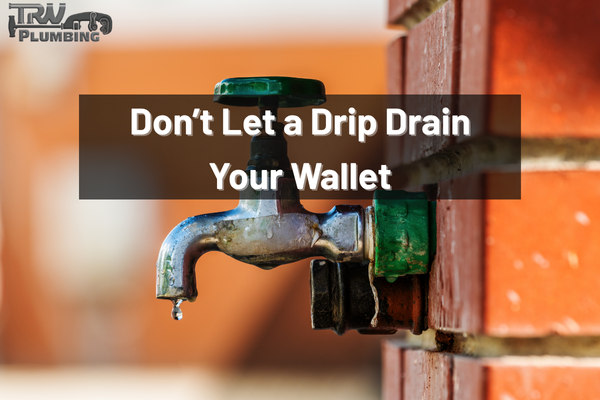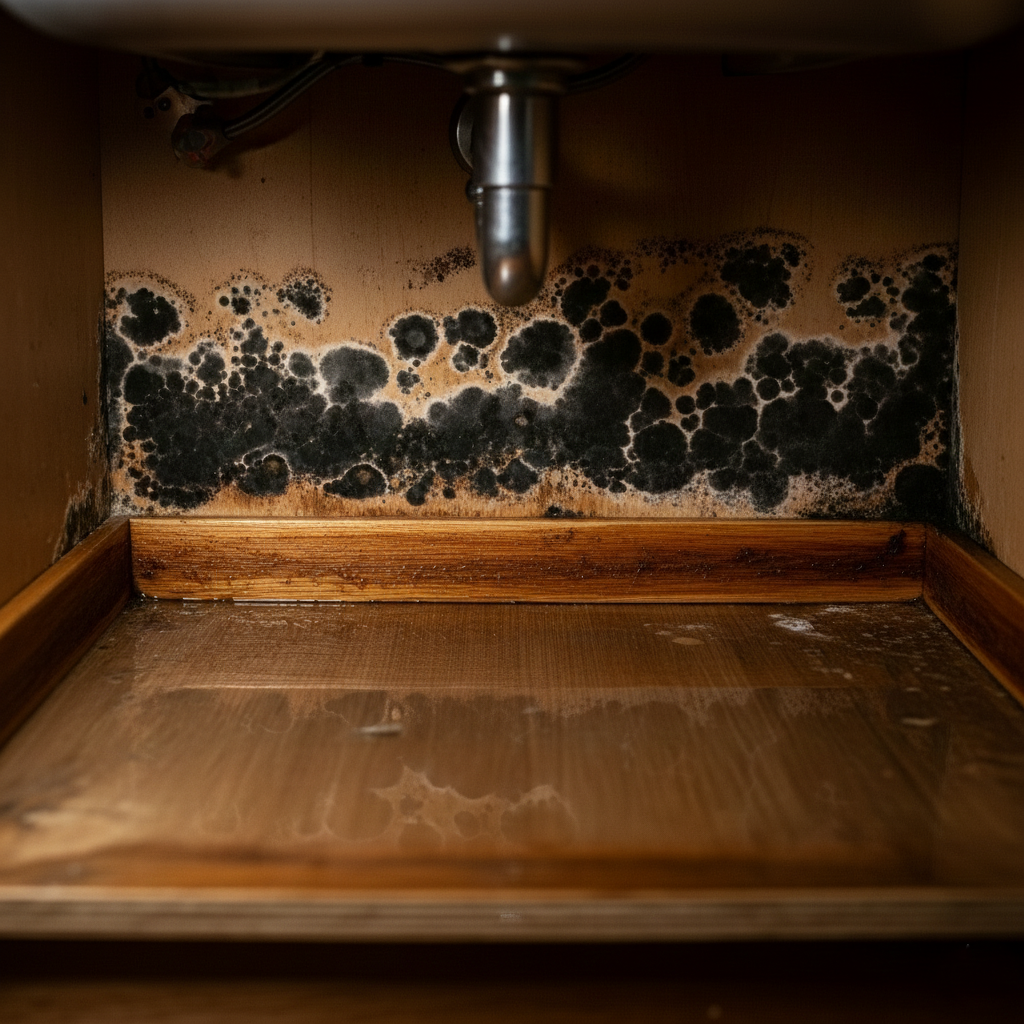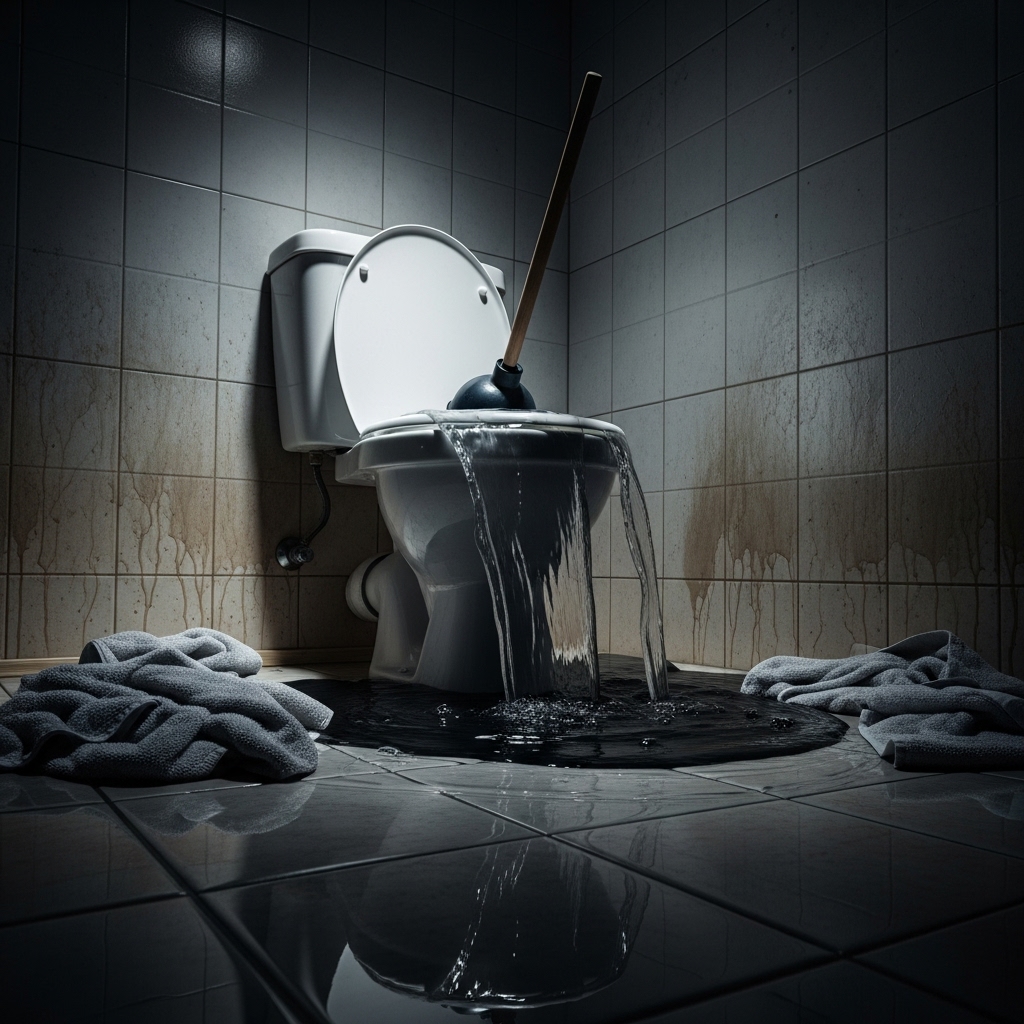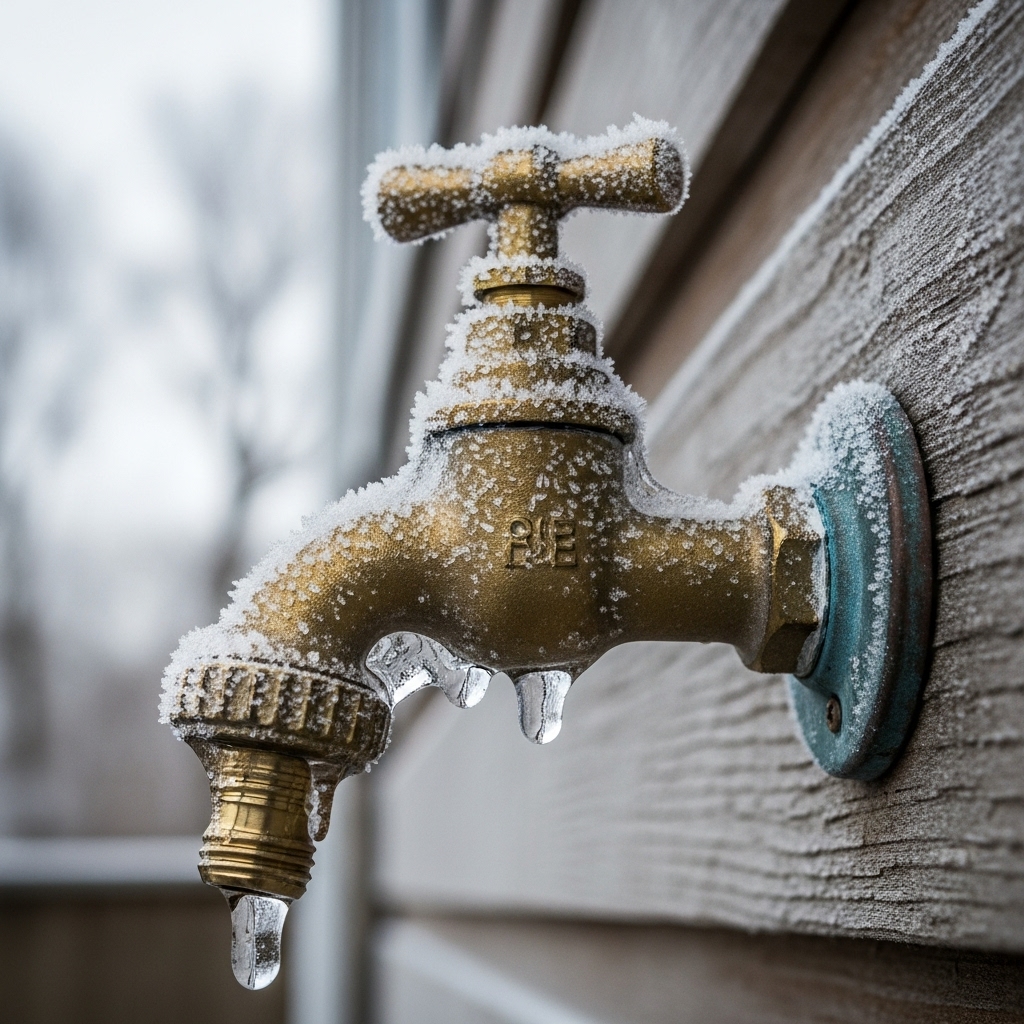The Leak You Didn’t See Coming
It’s the middle of July in Idaho. Whether you’re in Boise’s Foothills, maintaining your Caldwell garden, or keeping your Twin Falls lawn green despite the 95-degree heat, you’re using plenty of water. You’re washing the car every weekend and watering your vegetable garden religiously. Then the water bill arrives, and your heart sinks. It’s $180 higher than usual.
You double-check the sprinklers, wonder if the kids left the hose running, and finally walk around to the side of your house. There it is: a slow, steady drip from the outdoor faucet that’s been quietly leaking for weeks, maybe months.
Sound familiar? As a 3rd generation journeyman plumber with over 15 years serving Idaho families from Boise to Twin Falls, I’ve seen this scenario play out hundreds of times. Outdoor faucet leaks are the silent budget killers that catch homeowners completely off guard—especially during our intense summer months when every drop counts.
Here’s what every Idaho homeowner needs to know about outdoor faucet leaks: how to spot them early, why they’re so common in our climate, and most importantly, how to stop them before they drain your wallet and potentially damage your home’s foundation.
1. Why Outdoor Faucet Leaks Are Epidemic Across Idaho
If you’re dealing with a leaking outdoor faucet, you’re definitely not alone. From Boise’s established neighborhoods like the North End and Highlands to Caldwell’s growing subdivisions and Twin Falls’ historic areas like Blue Lakes and Rock Creek, outdoor faucet failures are incredibly common. Last summer alone, our team at TRW Plumbing repaired over 300 outdoor faucets across the Treasure Valley and Magic Valley.
The reason is simple: Idaho’s extreme climate is absolutely brutal on plumbing systems, regardless of whether you’re at Boise’s elevation or down in the Snake River Canyon.
The Winter Damage Cycle
Our Idaho winters can drop to -10°F or lower across the region, and that freeze-thaw cycle wreaks havoc on outdoor plumbing. Here’s what happens:
When temperatures plummet, any water left in outdoor faucets and connecting pipes expands as it freezes. This expansion creates enormous pressure—up to 2,000 pounds per square inch—that can crack internal seals, damage washers, and even split the faucet body itself.
Many homeowners from Eagle to Jerome don’t properly winterize their outdoor faucets, leaving them vulnerable. Even if you think you’ve drained everything, water can remain trapped in the pipes behind your siding, where it freezes and causes damage you won’t see until spring.
Summer Stress Factors
When warm weather returns and you start using your outdoor faucets heavily—filling pools, running sprinklers, washing cars—those winter-weakened components finally give way. The constant on-off cycles, high summer water pressure, and UV exposure from Idaho’s intense sun accelerate the failure of already compromised parts.
Add Idaho’s notoriously hard water (averaging 15-25 grains per gallon across our service areas) with its high mineral content, and you’ve got a perfect storm for faucet problems. Those minerals build up inside valves and seals, preventing proper closure and creating persistent drips.
Regional Variations in Problems
Boise Metro Area Higher elevation homes in areas like the Foothills often experience greater pressure fluctuations and more severe freeze-thaw cycles. Homes built in the 1980s-2000s construction boom are now reaching the age where original outdoor faucets commonly fail.
Caldwell/Nampa Region Agricultural runoff and varying water treatment systems can affect water quality, leading to accelerated mineral buildup. Many homes in newer subdivisions have builder-grade outdoor faucets that weren’t designed for long-term durability.
Twin Falls/Magic Valley The combination of volcanic soil, extreme temperature swings, and very hard water creates unique challenges. Older neighborhoods near the Snake River Canyon experience additional pressure variations due to elevation changes.
The Hidden Cost Factor
According to the EPA’s WaterSense program, a single outdoor faucet dripping just once per second wastes 3,153 gallons of water annually. That’s equivalent to running your washing machine 180 times—and you’re paying for every single gallon.
With Idaho’s tiered water billing systems across different municipalities, that extra usage can bump you into higher rate brackets. What starts as a 50-cent-per-day drip can cost you $15-25 monthly in additional water charges, plus potential foundation damage if the leak pools around your home’s base.
2. The True Cost of Ignoring Small Leaks Across Idaho
Let me share a real example from last month. We got a call from a homeowner in a Meridian subdivision who’d been ignoring a “small drip” from her back patio faucet for most of the summer. When we calculated the waste, that innocent little drip had cost her family over $350 in additional water bills and created a soggy mess that damaged her concrete patio and attracted carpenter ants.
Here’s the math that’ll make you want to check your faucets right now:
Daily Waste Breakdown
- 1 drip per second = 5 gallons per day
- 5 gallons per day = 150 gallons per month
- 150 gallons per month = 1,825 gallons per year
Idaho Cost Reality Across Our Service Areas
Boise Area (as of August 2025):
- Tier 1 (0-6,000 gallons): $4.12 per 1,000 gallons
- Tier 2 (6,001-15,000 gallons): $4.58 per 1,000 gallons
- Tier 3 (15,001+ gallons): $5.23 per 1,000 gallons
Caldwell Area:
- Tier 1 (0-5,000 gallons): $3.95 per 1,000 gallons
- Tier 2 (5,001-12,000 gallons): $4.35 per 1,000 gallons
- Tier 3 (12,001+ gallons): $4.85 per 1,000 gallons
Twin Falls Area:
- Tier 1 (0-4,000 gallons): $3.85 per 1,000 gallons
- Tier 2 (4,001-8,000 gallons): $4.25 per 1,000 gallons
- Tier 3 (8,001+ gallons): $4.65 per 1,000 gallons
That “harmless” drip adds roughly $7-10 to your monthly bill across all our service areas. Over a typical 6-month outdoor season, you’re looking at $40-60 in wasted water costs. And that’s just for one faucet with a minor leak.
The Compound Problem
Most Idaho homes have 2-4 outdoor faucets. If multiple spigots are leaking—which is common since they usually fail around the same time due to similar age and exposure—you could easily waste 300+ gallons monthly, pushing your usage into higher rate tiers.
I’ve seen summer water bills jump by $150-250 solely due to undetected outdoor faucet leaks. That’s real money that could go toward family vacations, home improvements, or savings instead of literally dripping away into your yard.
3. Signs Your Outdoor Faucet Is Leaking (Even When You Can’t See It)
Not all leaks announce themselves with obvious dripping. Many of the costliest leaks I discover during inspections have been going unnoticed for months. Here’s what to watch for across Idaho’s diverse climate conditions:
Obvious Warning Signs
Visible dripping or puddles – If water continues dribbling minutes after you turn off the faucet, the internal washer or valve seat is likely worn out.
Wet spots that won’t dry – Persistent dampness around the faucet base, even during Idaho’s dry summers, usually indicates a steady leak.
Water stains on siding – Look for discoloration, mineral deposits, or water marks on the wall around your outdoor faucet.
Subtle Red Flags Most Homeowners Miss
Mold or mildew growth – Check the siding, foundation, or nearby deck boards for signs of constant moisture.
Unusually green grass – If the area around your faucet stays greener than the rest of your lawn without extra watering, you might have a leak.
Soft or spongy ground – Step around your outdoor faucets. If the soil feels unusually soft or squishy, water may be pooling underground.
Strange sounds – Listen for whistling, squealing, or gurgling when you turn the water on or off. These noises often indicate internal damage or air in the lines.
Foundation issues – Cracks in concrete, settling pavers, or mushy spots in your foundation plantings can all signal underground leaks.
Ice buildup in winter – Unusual ice formation around outdoor faucets during freezing weather often indicates ongoing leaks.
The Water Meter Test
Here’s a professional trick I teach homeowners: Turn off all water in your house, including ice makers and automatic sprinklers. Check your water meter and write down the reading. Wait 2 hours without using any water, then check again. If the numbers have changed, you’ve got a leak somewhere—and outdoor faucets are often the culprit.
Regional-Specific Warning Signs
High-Elevation Areas (Boise Foothills, etc.) Watch for pressure-related damage like cracked faucet bodies or loose connections, which are more common at higher elevations.
Agricultural Areas (Caldwell/Nampa) Be alert for accelerated mineral buildup and corrosion due to varying water quality from agricultural runoff treatment systems.
Canyon Areas (Twin Falls) Look for erosion patterns around foundations, as the volcanic soil common in these areas shifts dramatically when oversaturated.
4. Complete DIY Diagnostic Guide for Idaho Homeowners
Before calling a professional, you can perform a thorough outdoor faucet inspection yourself. Here’s the same systematic approach I use on service calls across our three-region service area:
Tools You’ll Need
- Flashlight or headlamp
- Adjustable wrench
- Screwdriver set
- Garden hose
- Paper towels or rags
- Your phone camera (for documenting issues)
- Thermometer (for checking temperature variations)
Step-by-Step Inspection Process
Step 1: Visual Examination Walk around each outdoor faucet during daylight. Look for obvious drips, water stains, rust, or corrosion. Take photos of any damage you find—these help when calling for professional estimates.
Step 2: Handle Test Turn each faucet fully on, then completely off. The handle should turn smoothly without excessive force. If you have to crank hard to shut off the water, internal components are likely worn.
Step 3: Drip Test After turning off the faucet, wait 5 minutes and check for drips. Even one drop every few seconds indicates a problem that will get worse over time.
Step 4: Pressure Test Attach a hose and turn the water on full blast. Listen for unusual sounds and watch for water spraying from unexpected places around the faucet body or connections.
Step 5: Underground Check Feel the ground around each faucet. It should be dry or only slightly damp from normal use. Consistently soggy soil suggests a leak in the pipe behind your siding.
Step 6: Winter Damage Assessment (Spring Only) Check for freeze damage by looking for cracks, loose connections, or mineral deposits that indicate water was present during freezing weather.
Red Flags That Need Immediate Attention
- Water spraying from the faucet body itself
- Loose or wobbly faucet handles
- Rust stains or mineral buildup
- Cracks in the faucet housing
- Water appearing inside your crawlspace or basement near exterior walls
- Unusual pressure variations between faucets
Elevation-Specific Considerations
Higher Elevation Homes (4,000+ feet) Pay extra attention to pressure-related damage and freeze-thaw crack patterns, which are more severe at higher elevations.
Valley Floor Properties Focus on mineral buildup and hard water damage, which tends to be more severe in lower elevation areas with different water sources.
5. DIY Repairs vs. When to Call TRW Plumbing
Not every outdoor faucet problem requires a professional plumber. Some issues are perfect weekend DIY projects if you’re handy with basic tools. Others, however, can turn into expensive disasters if tackled incorrectly—especially in Idaho’s challenging climate conditions.
Safe DIY Fixes You Can Handle
Tightening the Packing Nut The packing nut sits behind the faucet handle and can loosen over time, especially during freeze-thaw cycles. Using an adjustable wrench, gently tighten it clockwise—but don’t over-tighten, as this can damage the threads.
Replacing Washers and O-Rings This is the most common outdoor faucet repair across Idaho. Turn off the water supply, disassemble the faucet handle, and replace the rubber washer inside. Take the old washer to your local hardware store (Home Depot, Lowe’s, or regional suppliers) to ensure you get the exact size.
Applying Thread Tape If water leaks where your hose connects to the faucet, wrap the threads with Teflon tape (clockwise) before reattaching the hose. This is especially important in areas with high mineral content water.
Basic Hose Bib Replacement If you’re comfortable with basic plumbing, you can replace a standard hose bib. Shut off the water supply first, and consider this a good opportunity to upgrade to a frost-free model designed for Idaho’s climate.
Essential DIY Safety Tips for Idaho Conditions
- Always shut off water at the main valve before major repairs
- Be extra cautious with older galvanized pipes common in pre-1980s Idaho homes
- Test your work carefully before considering the job complete
- Don’t over-tighten connections—hand-tight plus a quarter turn is usually sufficient
- In hard water areas, consider replacing mineral-clogged internal components rather than just cleaning them
When to Call TRW Plumbing Immediately
Structural Damage If you see cracks in the faucet body, corrosion on connecting pipes, or any signs of water damage to your home’s siding or foundation, stop and call us. These issues require professional assessment and often indicate larger problems.
Water Behind Walls If you suspect water is leaking inside your walls or crawlspace, don’t attempt DIY repairs. Water damage spreads quickly and can cost thousands to remediate—especially in Idaho’s dry climate where homeowners often don’t notice moisture problems until they’re severe.
Pressure Issues Low water pressure, inconsistent flow, or water hammering (loud banging in pipes) often indicate problems beyond the faucet itself. These are particularly common in Boise’s higher elevation neighborhoods.
Frozen Pipe Damage If you discover freeze damage when turning on faucets in spring, call professionals immediately. Frozen pipes can burst suddenly, causing major flooding.
Complex Sprinkler Integration Many Idaho homes have automatic sprinkler systems integrated with outdoor faucets. These complex valve arrangements require specialized knowledge to repair properly.
The Cost of Getting It Wrong
I’ve seen too many DIY repairs that started as $15 washer replacements turn into $1,200 emergency calls. Last winter, a well-meaning homeowner in Star attempted to replace a leaking outdoor faucet himself. He accidentally damaged the supply line inside the wall, which burst during the next cold snap and flooded his basement.
Professional outdoor faucet repairs typically cost $125-350, depending on the problem and location. Emergency water damage restoration can cost $3,000-10,000. When in doubt, call for a professional assessment.
6. Comprehensive Prevention Strategies for Idaho’s Extreme Weather
After 15 years of fixing preventable outdoor faucet failures across Idaho’s diverse climate zones, I can tell you that most problems are completely avoidable with proper seasonal care. Here’s your month-by-month guide to keeping your outdoor faucets leak-free:
Fall Winterization
Interior Shut-Off Every outdoor faucet should have an interior shut-off valve, usually located in your basement, crawlspace, or utility room. Turn these off completely by early October across all our service areas.
Drain Procedure After shutting off interior valves, go outside and turn on each faucet to drain any remaining water from the pipes. Leave the outdoor faucets open all winter—this is crucial in Idaho’s freeze-thaw climate.
Faucet Covers Install insulated faucet covers on every outdoor spigot. I recommend heavy-duty foam covers available at local hardware stores—they cost about $5-8 each but can save hundreds in repair bills during Idaho winters.
Hose Removal Disconnect and store all hoses, sprinklers, and attachments by October 1st. Even “frost-proof” faucets can freeze if hoses are left connected, and this is one of the most common causes of winter damage I see.
Sprinkler System Coordination If you have automatic sprinklers, coordinate outdoor faucet winterization with your irrigation system blowout service.
Winter Monitoring
Monthly Checks During warm spells, visually inspect your faucet covers to ensure they haven’t blown off or shifted. Idaho’s winter winds can be fierce.
Ice Damage Watch After significant thaw-freeze cycles, look for ice buildup around faucets or new cracks in the faucet housing.
Foundation Monitoring Watch for ice formation or unusual moisture around your foundation during winter months, which could indicate underground leaks.
Spring Startup
Gradual Reopening Turn interior valves back on slowly in late March or early April, depending on your elevation and local conditions. Listen for unusual sounds that might indicate freeze damage.
Test Operation Turn each faucet on gently at first, then gradually increase to full flow. Check for leaks, strange noises, or reduced pressure.
Annual Inspection This is the perfect time for a comprehensive check of all outdoor plumbing. Look for winter damage before the busy summer season begins.
Summer Maintenance
Monthly Leak Checks During peak usage months, check each faucet monthly for new drips or damage.
Hard Water Protection Idaho’s mineral-rich water can clog internal faucet components. Consider installing a water softener if you haven’t already, or schedule regular maintenance cleanings.
UV Protection Idaho’s intense summer sun can degrade rubber seals and gaskets. Consider faucet covers even during summer months for south-facing spigots.
Pressure Monitoring Be alert for pressure changes that might indicate supply line problems, especially during peak usage periods.
Regional-Specific Maintenance Tips
Boise/Treasure Valley Area
- Higher elevation homes need extra attention to pressure-related wear
- Foothills properties should inspect for wind damage to faucet covers
- Watch for mineral buildup from the region’s moderately hard water
Caldwell/Nampa Region
- Agricultural area water quality variations require more frequent internal cleaning
- Be extra vigilant about mineral deposit removal
- Consider quarterly rather than annual professional inspections
Twin Falls/Magic Valley
- Extremely hard water requires aggressive mineral management
- Volcanic soil shifts demand careful foundation monitoring
- Canyon area wind exposure needs sturdy faucet protection
Professional Inspection Benefits
TRW Plumbing offers comprehensive outdoor plumbing inspections each spring and fall across all our service areas. During these visits, we check not just your faucets, but also sprinkler connections, hose bibs, and outdoor water lines. We catch problems early, often saving homeowners hundreds in emergency repairs and water waste.
Our seasonal inspection includes:
- Pressure testing of all outdoor faucets
- Internal component assessment
- Leak detection around foundations
- Winterization assistance (fall service)
- Hard water damage evaluation
- Upgrade recommendations for aging systems
- Regional-specific problem identification
7. When Small Problems Become Big Disasters
Let me tell you about one of the most expensive outdoor faucet leaks I’ve encountered in my 15 years of service. It happened two summers ago in a beautiful home in Eagle’s gated community. The homeowners noticed a small drip from their back patio faucet but figured it wasn’t worth calling a plumber for “just a drip.”
Over four months, that drip washed away soil around their foundation, created a perfect environment for carpenter ants, and eventually undermined their expensive stamped concrete patio. By the time they called us, the “simple” faucet repair had become a $6,200 foundation and concrete restoration project.
Foundation Damage: The Hidden Threat Across Idaho
Constant water around your home’s foundation is one of the most serious consequences of outdoor faucet leaks, and Idaho’s diverse soil conditions make this problem particularly dangerous across our service areas.
Treasure Valley Clay Soil The heavy clay soil common in Boise and surrounding areas expands dramatically when wet and contracts when dry. This expansion-contraction cycle can crack foundations and create settling problems.
Caldwell Area Agricultural Soil Modified agricultural soil in many subdivisions can wash away quickly when oversaturated, creating voids under foundations and walkways.
Magic Valley Volcanic Soil Twin Falls area volcanic soil shifts unpredictably when oversaturated, making foundation damage both more likely and more severe.
What Can Happen: Regional Examples
Soil Erosion Even a small leak can wash away soil that supports your foundation, creating voids that lead to settling and cracks. This is particularly problematic in Idaho’s diverse soil conditions.
Freeze Damage Water that pools around foundations can freeze in winter, expanding and creating pressure that cracks concrete. Idaho’s severe freeze-thaw cycles make this especially damaging.
Pest Attraction Carpenter ants, termites, and other destructive insects are drawn to consistently moist areas around homes. Idaho’s dry climate makes any moisture source particularly attractive to pests.
Basement Seepage Saturated soil around foundations often leads to basement moisture problems and potential flooding—a serious concern in areas with high water tables.
Real Idaho Case Studies
Case 1: Eagle Foothills Disaster A homeowner ignored a leaking outdoor faucet for an entire summer. The constant moisture created ideal conditions for carpenter ants, which damaged the wooden deck support structure. The higher elevation location made the wood moisture damage more severe due to temperature fluctuations. Total repair cost: $4,100, plus pest control treatments.
Case 2: Meridian Subdivision Surprise What appeared to be a simple faucet drip was actually a cracked supply line inside the wall. The leak had been saturating insulation and wooden framing for months before being discovered. The newer construction with modern materials actually made the damage more expensive to repair. Insurance covered most of the $8,300 repair, but the homeowners lost their finished basement to water damage.
Case 3: Twin Falls Success Story These homeowners called TRW as soon as they noticed their water bill increasing. We found a small leak that would have cost $65 to repair. Six months later, they thanked us—their neighbor’s identical leak had caused $2,200 in concrete damage due to the area’s expansive volcanic soil.
Case 4: Caldwell Prevention Win A proactive homeowner in a newer subdivision scheduled our spring inspection service. We discovered early freeze damage that would have failed completely by mid-summer. The $180 early repair prevented an estimated $1,500 in foundation landscaping damage and water waste.
Insurance Considerations Across Idaho
Most homeowner’s insurance policies cover sudden water damage but not damage from long-term leaks that could have been prevented. Don’t assume your insurance will cover outdoor faucet leak damage—prevention is always cheaper than restoration, and Idaho’s extreme weather makes damage more severe and expensive.
8. Understanding Idaho Water Systems and Local Challenges
Working across Idaho’s diverse regions for 15 years has taught me that each area presents unique challenges for outdoor plumbing systems, and understanding these differences is crucial for proper maintenance.
Regional Water Quality Variations
Boise/Treasure Valley
- Hardness: 12-18 grains per gallon (moderately hard to hard)
- Source: Combination of ground and surface water
- Key Issues: Seasonal pressure variations, moderate mineral buildup
- Special Considerations: Higher elevation areas experience greater pressure fluctuations
Caldwell/Nampa Region
- Hardness: 15-22 grains per gallon (hard to very hard)
- Source: Ground water with agricultural influence
- Key Issues: Variable water quality, accelerated mineral deposits
- Special Considerations: Agricultural treatment chemicals can affect rubber seals
Twin Falls/Magic Valley
- Hardness: 18-25 grains per gallon (very hard to extremely hard)
- Source: Snake River aquifer system
- Key Issues: Extreme mineral buildup, accelerated component wear
- Special Considerations: Volcanic minerals create unique corrosion patterns
How Hard Water Affects Outdoor Faucets
Mineral Buildup Calcium and magnesium deposits accumulate inside faucet valves, preventing proper sealing and causing persistent drips. This is most severe in our Twin Falls service area.
Accelerated Wear Hard water minerals act like sandpaper on internal faucet components, wearing out washers and seals faster than in soft water areas.
Corrosion Issues High mineral content can accelerate corrosion of metal faucet bodies, especially in older brass or iron fixtures common in pre-1990s Idaho homes.
Clogged Screens and Aerators Mineral deposits regularly clog faucet screens, reducing flow and creating pressure imbalances that stress internal components.
Pressure Variations Across Service Areas
Elevation Effects Homes in Boise’s Foothills (4,000+ feet) often experience higher pressure and more dramatic pressure swings than valley floor properties (2,500-3,000 feet).
Municipal System Differences Each city in our service area has different pressure standards and seasonal adjustments that affect outdoor faucet performance.
Seasonal Supply Changes Spring runoff, agricultural demands, and municipal conservation measures create pressure fluctuations that stress aging outdoor faucets.
Age-Related Challenges by Region and Era
Pre-1980s Homes (All Areas) Original outdoor faucets typically have brass or galvanized components that are well past recommended replacement age. These homes often lack interior shut-off valves.
1980s-2000s Construction Boom Era Homes from this period across all our service areas often have builder-grade outdoor faucets that are reaching end-of-life. Many lack proper freeze protection.
2000s-2010s Development Modern homes usually have frost-proof outdoor faucets, but they’re not maintenance-free. Hard water still affects these systems, and proper winterization remains critical.
Newer Construction (2010s+) Latest homes often have high-quality frost-proof systems, but installation quality varies. Professional inspection ensures proper setup and operation.
9. Choosing the Right Idaho Plumbing Professional
When DIY repairs aren’t enough—or when you want to prevent problems before they start—choosing the right plumber makes all the difference. Here’s what to look for when selecting a plumbing professional across Idaho:
Essential Qualifications
Idaho State Licensing Always verify your plumber holds a current Idaho contractor’s license. TRW Plumbing is fully licensed and bonded across all our service areas, which you can verify through the Idaho Division of Building Safety.
Regional Experience Idaho plumbing presents unique challenges that vary by region. Choose a plumber who understands the specific conditions in your area—from Boise’s elevation challenges to Twin Falls’ extreme hard water.
Insurance and Bonding Ensure your plumber carries both liability insurance and bonding. This protects you if something goes wrong during repairs.
Ongoing Education Plumbing codes and techniques evolve constantly. Look for professionals who invest in continuing education and stay current with industry standards.
Service Quality Indicators
Transparent Pricing Reputable plumbers provide clear estimates before starting work. At TRW, we offer free assessments for outdoor faucet problems and explain all costs upfront across all our service areas.
Warranty Coverage Professional repairs should come with warranties on both parts and labor. We provide 1-year warranties on outdoor faucet repairs and 5-year warranties on new installations.
Emergency Availability Plumbing emergencies don’t wait for business hours. Choose a company that offers real emergency service across your region, not just an answering machine.
Local References Ask for references from customers in your specific area. Local challenges require local expertise.
10. Advanced Troubleshooting for Persistent Problems
Sometimes outdoor faucet issues are more complex than simple washer replacements. Here are some advanced problems I encounter regularly across Idaho’s diverse conditions:
Pressure-Related Issues
Water Hammer If your outdoor faucets create loud banging noises when turned off quickly, you may have water hammer. This pressure shock can damage internal components and is particularly common in higher elevation Boise area homes. Solutions include pressure-reducing valves or water hammer arrestors.
Inconsistent Flow If water flow varies from strong to weak without adjusting the handle, you might have sediment buildup in supply lines or a failing pressure regulator. This is especially common in areas with high mineral content water.
Thermal Expansion Issues Idaho’s extreme temperature swings can cause thermal expansion problems in supply lines, leading to pressure spikes that damage faucet internals.
Internal Pipe Problems
Supply Line Leaks Sometimes what appears to be a faucet leak is actually a broken supply line inside your wall. Signs include water in crawlspaces, soft spots in interior walls, or dramatically reduced pressure. This is particularly problematic in older Idaho homes with galvanized or copper supply lines.
Freeze Damage Frozen pipes don’t always burst immediately. Sometimes ice damage creates hairline cracks that leak slowly all summer before failing completely. Idaho’s severe winters make this especially common.
Mineral Blockages Extreme hard water conditions, especially in the Twin Falls area, can create complete blockages in supply lines that require professional cleaning or replacement.
Electrical Complications
Frost-Proof Faucet Issues Modern frost-proof faucets have internal valves that can fail independently of external components. These often require complete replacement rather than simple repairs, and proper installation is crucial for Idaho’s climate.
Sprinkler System Integration Many Idaho homes have complex automatic sprinkler systems that integrate with outdoor faucets. These systems require specialized knowledge to repair properly and often involve multiple valves and pressure zones.
Smart Home Integration Newer homes may have outdoor faucets integrated with smart home water management systems. These require specialized diagnostic equipment and software knowledge.
Regional-Specific Advanced Issues
High-Elevation Problems (Boise Foothills)
- Pressure regulation failures due to elevation changes
- Expanded freeze-thaw damage cycles
- Wind-related stress on faucet mounting systems
Agricultural Area Issues (Caldwell/Nampa)
- Chemical corrosion from treated water
- Sediment buildup from agricultural runoff treatment
- Variable pressure from irrigation demand fluctuations
Canyon Area Challenges (Twin Falls)
- Extreme mineral buildup requiring specialized cleaning
- Volcanic soil settlement affecting supply line alignment
- Wind exposure causing accelerated component wear
Conclusion: Protecting Your Idaho Investment
Your home is likely your largest investment, and protecting it from water damage should be a top priority—especially in Idaho’s challenging climate conditions. Outdoor faucets might seem small, but they can cause big problems if left unchecked, especially during the freeze-thaw cycles common in Twin Falls and the greater Magic Valley region.
By performing regular inspections, winterizing in the fall, and knowing when to call in a professional, you’re not just avoiding costly repairs—you’re also improving your home’s overall efficiency and value. A leaky outdoor spigot can waste thousands of gallons of water per year, drive up utility costs, and lead to long-term structural damage.
Whether you’re a DIYer looking to get your hands dirty or a homeowner who prefers to leave plumbing to the pros, being proactive makes all the difference. Use the seasonal maintenance guide, keep an eye on your water bill for unexplained spikes, and don’t hesitate to contact a trusted local plumber if something seems off.
At TRW Plumbing, we’re proud to serve the Twin Falls community with honest, high-quality plumbing services backed by warranties and real local experience. From Rock Creek to Blue Lakes Boulevard, we know the homes, we know the codes—and we’re here to help.
Frequently Asked Questions (FAQ)
Q: Why is my outdoor faucet leaking even when it’s turned off?
A: This often means the washer or valve seat inside the faucet is worn or damaged. In cold climates like Twin Falls, freeze damage can also cause internal cracks that lead to leaking—even when the faucet is shut off.
Q: Can I fix a leaking outdoor faucet myself?
A: Yes, many minor leaks can be fixed DIY with a wrench, plumber’s tape, and a replacement washer. But if the pipe behind the wall is cracked or corroded, it’s best to call a professional plumber to avoid further damage.
Q: How much does it cost to repair a leaking spigot in Twin Falls?
A: A basic repair can range from $50 to $150. If the pipe inside the wall is damaged, it may cost $250 or more, depending on access and materials. Keep in mind that letting the leak persist can lead to much higher costs over time.
Q: When should I replace my outdoor faucet instead of repairing it?
A: If the faucet is over 15 years old, shows signs of corrosion, or has frozen and burst in the past, replacement may be more cost-effective than ongoing repairs.
Q: How can I prevent outdoor faucet leaks in the winter?
A: In Idaho, it’s important to shut off and drain outdoor spigots before the first freeze. Use insulated faucet covers and consider upgrading to frost-free hose bibs for better year-round protection.
This blog was written in partnership with LeadProspecting Ai—helping Twin Falls businesses grow with smarter content, local SEO, and workflow automation.






